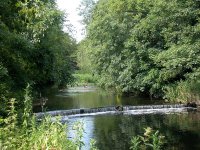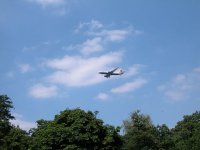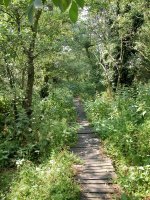

Hounslow Heath
The London
Loop enters Hounlsow from Whitton, on the southeastern edge of Hounslow
Hearh. The heath is a forgotten corner of open country. It has all the
appearance of true virgin heathland, being a square kilometer or so of
sandy soils supporting rough grasses, broom, gorse and a scattering of
trees.



The London LOOP crossing Hounslow Heath
From the stile take the path straight ahead; this soon bends
gently to the left. A couple of hundred metres further on, just short
of a bench seat, go half left to follow a track heading just south of
west; you're heading pretty much straight for a church spire in the
distance.


The main track across Hounslow Heath
It's a pretty amazing landscape, this. You can see signs of
habitation all around but the heath is wild and unfrequented. There
must be a population of ten thousand people within a mile of its
boundaries but it seems that very few of them come here; maybe its the
lack
of facilities (car parks, cafes, childrens' play areas, etc) that keeps
the general public away. That's to the advantage of walkers like us who
like to enjoy the peace and solitude of open spaces. Not only is the
heath gloriously empty, it is also picturesque; the walking is pleasant
and the scenery switches from open to semi-wooded areas. Eventually you
come to a T-junction with a major track hard up against a belt of
trees; this is the boundary of the heath and there is a golf course
beyond. Turn right and follow the track northwest.



Hounslow Heath - the western boundary track
Stay on this track for just over 300 metres, at which point
you reach an open area, the crossing point of several tracks. There is
scope for confusion here. The LOOP continues hard left through the
trees, and is meant to follow a gully down a slope. I missed the gully
and had to make my way down the earth bank; there is a small maze of
paths and tracks hereabouts. Once at the foot of the slope, however,
turn left and follow a track.

Approaching the Crane from Hounslow Heath
Cross an open area and continue in the same direction. The
path very shortly reaches a couple of bridges; the second and larger of
the two crosses the Crane, which we last saw nearly two miles back in
Whitton. Cross this bridge and turn right, along the riverbank. The
LOOP now follows the Crane all the way through the rest of Hounslow and
a little way beyond.
North Feltham





The banks of the Crane at North Feltham
This next section of riverbank path is about a kilometer in
length. The residential roads of North Feltham are not far to your left
but you see little of them, just the occasional opening in the trees.
This is a pleasant stretch (arguably the best part of the LOOP through
Hounslow) with ribbons of woodland on both banks.





The banks of the Crane, North Feltham
You reach a single-arch bridge (giving access to heaven
knows where) after six hundred metres, and shortly after that is a
picturesque little weir. The houses start to close in on the left now
and the ribbon of woodland becomes much narrower. Shortly afterwards
you
see another bridge ahead. The path goes slightly left to drop you
beside a filling station on the edge of North Feltham; the bridge is
known as Baber Bridge and it carries the A315 Staines road.



The Staines road at Baber Bridge; Donkey Wood
Cross the road and find the entrance to Donkey Wood, on your
right before the river bridge. There are a couple of side streams here
and it's a confusing place. Cross the wooden footbridge to your right;
it bridges a mill stream, not the Crane proper, which is a little way
ahead. Despite the feeling that you're heading the wrong way, don't
turn and follow the bank of the mill stream but take the path onwards
through the wood; it rejoins the Crane in a couple of hundred meters.



Underneath the Heathrow flight path
Continue once more along the banks of the Crane, which start
to get a bit wilder. Donkey Wood is a wildlife area, never more than a
couple of hundred meters wide but about a kilometre long. Glimpses of
low-flying planes not far ahead tell you that you're very near the
flight path of Heathrow Airport's south runway.
Hatton Cross



The Crane in Donkey Wood
The path through Donkey Wood gets quite narrow and
substantial parts of it are carried on wooden decking, as the ground
below is boggy. Both banks of the river are fairly choked with
vegetation and the path is narrow; it's not fun if you meet anyone
coming the other way. Aircraft continue to fly low overhead, on their
way to touch down little more than a mile away at Heathrow.



The Crane, approaching Hatton Cross
The path gets squeezed up against a high chainlink fence
now. We're approaching the huge area of warehousing that stands just
this side of Heathrow; there are industrial units to your right and a
reservoir (unseen) to your left.




The LOOP at Hatton Cross
The half mile of LOOP adjacent to Hatton Cross is without
doubt the most disappointing stretch of the whole path so far. You pass
under a road, after which the path deteriorates markedly and gets
squeezed between a wall of factory fences to your left and a high,
crumbling bank to your right. This section of the path is going to need
some attention before long or it will become unviable. It is choked
with vegetation, ill-defined and obviously little-used. But press on,
and in 300 metres you will arrive at the busy A30 trunk road.
A good number of walkers will break the journey here and walk to Hatton Cross underground station a kilometre to the west along the main road, or perhaps get a bus into Hounslow in the other direction. Those of you who are continuing to Cranford or beyond will find the map confusing here; my edition of the LOOP's official guide has you crossing the road "a few paces to the left" to continue alongside the Crane. However, unless I missed something obvious, this is not viable; a short section of London Underground's Piccadilly Line comes to the surface across the road and can't be crossed here. Instead, walk west along the A30 for some 250 metres until you reach a junction with a service road on the north side. You're about to leave Hounslow temporarily and cross into Hillingdon; the borough boundary follows the edge of the road just here. Cross the A30 carefully and go a few paces along the side road heading north, then turn right again for a rough works road that runs north (i.e. to the left) of the emerging railway line. It runs past a hedge towards some sorry-looking industrial units and sheds at the far end and a bold notice inform you that there is no authorised access. Sparing a glance at the huge British Airways aircraft hangars to your left, walk along this track. It's approaching the Cranebank industrial estate but just before you reach this you cross the Crane again; turn left to find the footpath and the continuation of the LOOP. The borough boundary follows the river so you have now returned to Hounslow after the brief incursion into Hillingdon.
A good number of walkers will break the journey here and walk to Hatton Cross underground station a kilometre to the west along the main road, or perhaps get a bus into Hounslow in the other direction. Those of you who are continuing to Cranford or beyond will find the map confusing here; my edition of the LOOP's official guide has you crossing the road "a few paces to the left" to continue alongside the Crane. However, unless I missed something obvious, this is not viable; a short section of London Underground's Piccadilly Line comes to the surface across the road and can't be crossed here. Instead, walk west along the A30 for some 250 metres until you reach a junction with a service road on the north side. You're about to leave Hounslow temporarily and cross into Hillingdon; the borough boundary follows the edge of the road just here. Cross the A30 carefully and go a few paces along the side road heading north, then turn right again for a rough works road that runs north (i.e. to the left) of the emerging railway line. It runs past a hedge towards some sorry-looking industrial units and sheds at the far end and a bold notice inform you that there is no authorised access. Sparing a glance at the huge British Airways aircraft hangars to your left, walk along this track. It's approaching the Cranebank industrial estate but just before you reach this you cross the Crane again; turn left to find the footpath and the continuation of the LOOP. The borough boundary follows the river so you have now returned to Hounslow after the brief incursion into Hillingdon.


Cranebank
Cranebank is not a great deal more salubrious than the
section of path we just left; it has a rough, unkempt feeling but the
provision of a bench seat proves that this is a public space and that
someone, somewhere, cares for it. Shortly afterwards the path improves
and passes a gate into a field to your right; continue onwards, leaving
the environs of the Cranebank industrial estate behind and approaching
the locality of Cranford.
Cranford


Pastures south of Cranford
Cranford would presumably once have been a village (where
there was a ford across the Crane, obviously) but situated as it is at
the northeast corner of Heathrow it has grown, and is not the most
pleasant of London's localities. The riverside path comes out to an
open
area south of a housing estate (second picture above). Before you reach
the hedge seen in the picture, track diagonally to the right across the
pasture to reach the gate at the southern end of Wayne Avenue. Here
you're more or less under the flight path of Heathrow's north runway so
there may well be low flying planes passing overhead. Follow the road's
left-hand branch, and around the bend to the right at the top, then
left out on to the main A4 (first picture below).



Bath Road at Cranford